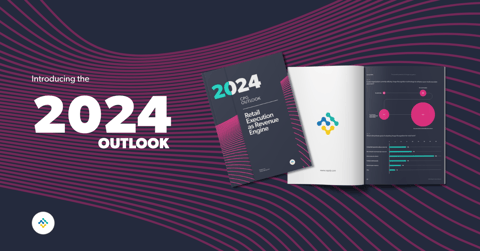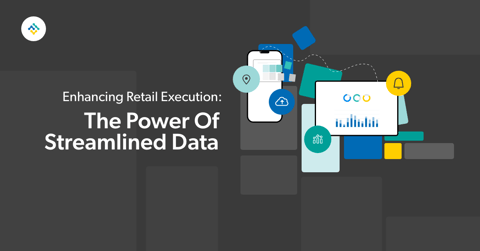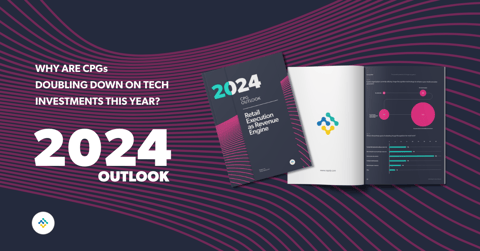The retail industry has undergone a significant transformation in recent years. Don’t worry, this isn’t another article bemoaning the rise of e-commerce and exaggerating the decline of physical retail. Despite these common concerns, retail of all kinds is alive and well — but today, brands must recognize the growing importance of data.
The rise of big data isn’t a new development; In fact, it’s one of the most often-discussed topics among business leaders today. However, in the retail industry, companies are still struggling to put data-driven strategies into action. The Harvard Business Review recently conducted a study and among the retail enterprises they surveyed, only 5% qualified as data-driven organizations.
Whether you have no experience with data-driven retail, or simply want to improve your business strategy, this blog post will offer several important considerations brands must make in order to plan and, more importantly, execute a successful data-driven business strategy.
What is Data-Driven Retail?
A data-driven organization uses insights gleaned from data analysis to inform each and every business decision and strategy. In the retail industry specifically, companies can leverage data to make more strategic decisions related to customer interaction, product development, pricing, and so much more. Even seemingly menial details like a product’s placement on a store shelf can be influenced by data-driven insights.
What Are The Benefits of a Data-Driven Retail Strategy?
Over the years, we’ve watched many once-successful retailers downsize or go out of business completely. Despite this, the brands selling in these stores manage to thrive and multiply. With such dense competition, there’s no denying that data-driven brands have a distinct advantage over their competitors. Let’s look at a few specific benefits of a data-driven retail strategy:
Deliver a More Personalized Customer Experience
Modern customers have the world at their fingertips. As a result, they have more power than ever before in the buyer-seller relationship— and they’ll only buy and continue to buy from brands who deliver rewarding experiences they can’t get elsewhere.
There’s no questioning that personalized marketing is critical to business success — but research suggests that brands are still far from realizing the potential of personalization. In fact, only 22% of shoppers are satisfied with the current level of personalization from brands.
Whether you’re tailoring your brand and products to speak to your customers’ needs, or offering real-time recommendations based on their behavior, you need access to accurate customer data for effective personalization.
Predict Future Customer Behavior
What if you could predict precisely who will buy a product, when they’ll buy it, and the method they’ll use to make the purchase? While customer data won’t give you superhuman psychic abilities, it’ll enable you to get as close to predicting the future as humanly possible.
By analyzing trends, past behavior, purchase history, and many more data points, brands can pinpoint every factor that contributes to a purchase decision. With this information, you can accurately predict future customer behavior and adjust your marketing efforts accordingly.
Since this point is so crucial, let’s look at an example. Pretend your company sells outdoor recreation apparel and equipment. A person visits a store and buys a pair of your hiking boots. By examining past customer data, you uncover an important correlation: customers who buy those boots often return to the same store and buy a specific hiking backpack your company manufactures. Using this information, you send a limited-time promotional offer to the customer who bought the hiking boots. Sure enough, they return within a week and purchase the hiking backpack.
Make Strategic Pricing Decisions
Here’s another issue we can thank the Internet for: brands must be incredibly strategic with their product pricing. Why? Simply put, a customer can walk into a store, find the exact thing they’re looking for, and still leave without making a purchase— all because they pulled out their smartphone and found out one of your competitors offers the same product for a better price.
It’s no longer sufficient to set pricing based on your own standards of quality, production costs, and revenue goals. Brands must constantly cultivate competitive intelligence, customer feedback, and other first- and second-party data types to strategically set product prices.
Beyond the initial price of a product, data-driven brands can also take a more strategic approach to sales, discounts, promotions and other temporary price reductions.
Optimize In-Store Product Display
The next time you visit a grocery store, pay attention to where certain products are located. Why do we always see gum, candy, individual drinks, and magazines located by the registers? Because customers don’t typically seek these products out, but are likely to grab one as they’re waiting in line. Why is the meat and produce often in the back? Because customers actively seek out these essentials, but they might grab an item they didn’t plan on buying as they walk all the way to the rear of the store.
Optimal in-store product placement isn’t always so obvious. But through data analysis, you can strategically test and optimize the placement of their products to maximize profit.
Keep in mind: these are just a few of the many benefits of a data-driven retail strategy. But rather than continue telling you how data will improve your business, we’re going to move on to the main topic of this post — the key considerations you must make for a successful data-driven retail strategy.
5 Key Considerations for a Data-Driven Retail Strategy
A data-driven business strategy doesn’t happen overnight. It’s a complex strategic shift, the success of which hinges on a number of equally important factors. Here are some specific considerations brands should keep in mind before embarking on their own data-driven retail strategy.
1. Identify Primary Data Sources
The difficulties if data collection are what scare many brands off from embracing a data-driven strategy. After all, modern technology makes it easy to trace a customer’s digital footprint and gather large quantities of data— but how can brands gather data from people buying products in-person?
If you’ve had this reservation in the past, it’s time to get rid of it. Whether customers buy your products in brick-and-mortar stores or online, there are a number of ways to collect retail customer data.
Here’s the key: one of these methods alone won’t deliver all the data you need. You must collect data from a variety of sources in order to reap the myriad benefits of a data-driven strategy. Here are some ideas:
Point-of-Sale (POS) Data:
A POS system is the technology used to complete a transaction with a customer. But, it’s also the most valuable source of customer data.
For starters, brands can use POS data to automatically track their inventory and maintain proper stock levels. More importantly, POS data reveals crucial product and customer insights that can drive your decision-making:
- Track a customer’s order history to send them personalized recommendations and predict future behavior.
- Identify trends related to specific product sales, such as a spike in sales for a certain product during the summer season.
- Discover which products are frequently bought together in order to optimize their placement in stores or offer unique product bundles.
The main benefit of POS data is that it doesn’t require additional effort from the customer. They are already making a purchase, so you’re not asking them to go out of their way to provide you with personal information.
Customer Feedback:
Use surveys and polls, whether digitally or in-person, to gain insight into your customers’ buying preferences, their favorite and least favorite products, their feelings about your brand, and any other interesting factors.
If you want to maximize the amount of feedback you receive from a survey or poll, we recommend including it as part of a promotional contest or giveaway. For example, send an email to your customer list that offers 20% off their next purchase in exchange for completing your survey.
Web Analytics:
We assume your company has some sort of online presence, be it a robust digital store or a basic company website. Either way, the Internet is a massive source of data that offers important insights into your audience and how they interact with your brand.
Competitive Intelligence:
Due to the sheer quantity of existing and emerging brands, it’s important to stay in the know about your competitors. For instance, imagine you launch a new product and sell it for $100, having no idea that a competitor already offers a nearly identical product for $75. Your product might still sell on the strength of your brand alone, but you’d likely miss out on a lot of customers who opt for the more affordable product.
There are several effective methods to use to collect competitive intelligence. These include performing observational research, obtaining market intelligence reports from official sources, or conducting win/loss analyses to learn why you lost customers to a competitor.
2. Integrate Your Data Sources to Facilitate Omnichannel Customer Experiences
Omnichannel strategies are now standard in the retail industry. If you’re unfamiliar, omnichannel retail ties together all of the channels a customer uses to make a purchase in order to provide the most seamless customer experience. When you order a product online to pick up in-store, or earn digital reward points for in-store purchases, that’s omnichannel retail at work.
However, data is the fuel that drives omnichannel retail— and if your data is siloed or stored in separate locations, delivering an omnichannel experience will be all but impossible. You’ll struggle to glean any actionable insights from your disparate data sources and you’ll run into roadblocks that prevent seamless hand-offs between digital and in-store channels.
For these reasons, it’s crucial to invest in a platform that stores all of your customer and product data in one centralized location. Not only will this enable an effective omnichannel strategy, it will also facilitate more accurate and efficient data analysis to inform all of your data-driven initiatives.
3. Build Comprehensive Buyer Personas
No data-driven strategy is complete without in-depth, accurate buyer personas. If you’re not familiar with the concept, buyer personas are semi-fictional profiles of your ideal customers, made up of a combination of existing customer data, quantitative research, and anecdotal observations.
Buyer personas help you understand your customers, their buying preferences, and much more. They allow you to tailor your entire retail strategy to effectively attract more of your ideal customers.
While buyer personas are not a new concept, many brands fall short by using buyer personas that aren’t comprehensive enough. If the bulk of your personas are made up of basic demographic information, it’s time to consider some additional data types. We find it helpful to think of these categories as the ‘what’, ‘how’ and ‘why’ of your personas.
Purchase History:
What do your customers purchase? More specifically, what kinds of products do your ideal customers buy before or in addition to buying your products? A person’s purchase history is a valuable piece of information as it can often help you predict their future purchases.
Buying Preferences:
How do your customers make purchases? Do they prefer to buy products online, or in-store? Do they tend to buy in bulk or purchase one product at a time? Understanding your customers’ buying preferences will help inform major strategic decisions concerning how you sell and market your products.
Psychographic Data:
Why do your customers make purchases? Psychographic data refers to seemingly unquantifiable characteristics such as a person’s personality traits, interests, motivators, values and hobbies. This type of data is typically collected through surveys, market research, and observation. To put it simply, demographics help you understand who a person is — their age, gender, location, etc. — but psychographics help you understand why customers buy what they buy.
As a general rule of thumb, you should be able to look at your buyer personas and visualize real, living customers. The more life-like your personas are, the more targeted and strategic your retail strategy will be.
4. Create a Data-Driven Business Culture
This is one of the most important, yet one of the most overlooked, elements of a successful data-driven retail strategy. It’s not enough to hire a single data analyst, or even a team of analysts, to collect, analyze and report on your customer data. You’d have a data-driven program, but you wouldn’t be a data-driven company.
Instead, educate your entire staff on your data-driven strategy and what it entails. For instance, an entry-level employee who interacts with customers might not be manually collecting or analyzing data— but should still have a basic understanding of how and why your company uses this information.
5. Prioritize Data Hygiene
The many benefits of a data-driven strategy depend on one factor above all else: the quality of your data. With inaccurate, outdated, or incomplete data, your retail strategy will be ineffective at best— and downright detrimental to the success of your business at worst.
Consider the following scenario: you collect contact data from the customers who purchase your products, and then assemble a targeted marketing campaign that aims to drive these customers to make another purchase. But, by the time you’ve launched your campaign, much of your contact data is already outdated. If this sounds like an unlikely problem, consider these statistics from Kissmetrics:
- 40% of email users change their email addresses at least once every two years.
- 15% of email users change their email address one or more times a year.
- 20% of all postal addresses change every year.
- 18% of all telephone numbers change every year.
Even if your data collection strategy is airtight, you’ll still run into the problem of data decay over time. So, be sure to take the necessary steps to prioritize ongoing data maintenance. We recommend partnering with a data provider to handle the heavy lifting and keep your data clean, allowing you to focus on making smarter data-driven decisions.
Final Thoughts
The retail industry has undoubtedly changed— but the same is true for every industry in our post-digital business environment. If you primarily sell in retail, don’t fret about the negative impacts the digital evolution might have on your company. Instead, consider the ways in which data can empower your business to exceed its goals and achieve unprecedented growth.




